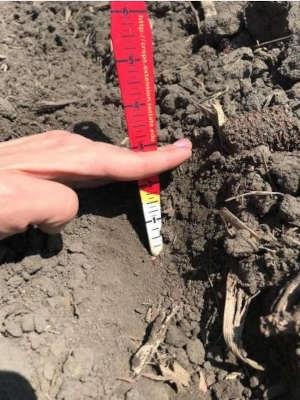However, in a dry spring, soybean seed should be planted into a zone of moist soil if it can be found at a reasonable planting depth. This spring, planting into moisture may mean planting deeper than 1.5 inches and possibly more than 2 inches deep. Planting deep (>2 inches) comes with risks. It can put the soybean seed at risk of running out of carbohydrate reserves prior to emergence and increased risk of pathogen infection due to increased time to emerge. Additionally, soybeans planted deeply in tilled soils may be at more risk of stand loss from soil crusting when rainfall comes due to lack of energy to push through. Soybeans with poor seed quality or lower emergence/vigor ratings will be at enhanced risk for stand loss at deeper seeding depths.
Planting at a normal depth into dry soils and waiting for rainfall is a management strategy some may be tempted to choose, but that seed will face challenges as well if rainfall is not in the near-term forecast. Tilled soils may pack down or wash when rainfall comes, potentially resulting in seeds placed shallower than intended – this is much more problematic for corn than soybean. If rainfall wets soils unevenly or comes in small amounts, seed will imbibe water and emerge unevenly. A worst-case scenario would be seed that imbibed water but did not have enough water to sustain plant development following imbibition. Soybean seed will likely survive in a dry soil for significant time, but non-uniform emergence or reduced stands from dry soils are likely to be more problematic than deeper planting depths.
How deep is too deep?
This likely depends on several characteristics, including soil conditions, soybean variety, and seeding rate. Soybean can tolerate depths up to 3 inches, but some stand loss is possible due to the energy required to emerge from this depth. A 2014 published article from UNL’s CropWatch shared research demonstrating that soybean planted at higher seeding rates (140,000 or greater) suffered no yield loss from depths up to 2.75 inches. Soybeans seeded at lower seeding rates (105,000 or less) suffered some yield loss when planted shallower than 1.25 inches and deeper than 2.25 inches, likely due to increased stand loss at those depths. Farmers will want to carefully evaluate each field, soybean variety, and seeding rate, as well as their own tolerance for the risks associated with planting deeper than normal or into dry soil.

Planter adjustments for deeper planting
Mark Hanna published an ICM News article on “Planter Adjustments for Dry Soil” that is worth a read for more detailed information. Of note, dry soils and deeper planting likely mean increased down pressure on row units. Be sure to frequently check that seeding depth is what the monitor states. Use row cleaners to create a furrow and move dry soil to get the seed into better moisture, but be careful not to move too much soil causing a deep trench where the seed furrow will be. This is a reasonable approach that has worked well for some operators, but it comes with the risk of creating an area for water to either puddle or flow, depending on slope. Furrows on sloping ground may create an easy conduit for water to move and erode soil from the row, while furrows on flat ground will create potential for ponding and crusting. The risk of these situations all hinge on when and how rainfall arrives after planting.
Summary
While a timely rainfall will alleviate many of these seeding depth concerns, the forecast is daunting with little significant chance for rainfall at this point. Each day, evaluate field moisture status and depth to aid in making appropriate seeding depth decisions. While planting, check seeding depth frequently, and if possible, be sure to place seed in moisture for the most uniform start.
Source : iastate.edu